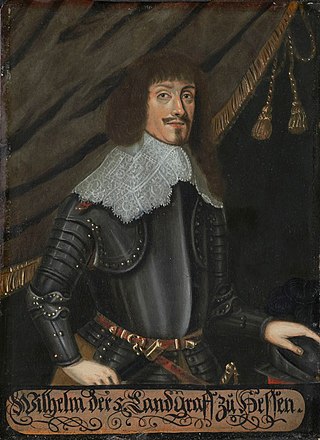
Hesse or Hessia, officially the State of Hesse, is a state in Germany. Its capital city is Wiesbaden, and the largest urban area is Frankfurt, which is also the country's principal financial centre. Two other major historic cities are Darmstadt and Kassel. With an area of 21,114.73 square kilometers and a population of over six million, it ranks seventh and fifth, respectively, among the sixteen German states. Frankfurt Rhine-Main, Germany's second-largest metropolitan area, is mainly located in Hesse.

This article is about the history of Hesse. Hesse is a state in Germany.

The House of Hesse is a European dynasty, directly descended from the House of Brabant. They ruled the region of Hesse, one branch as prince-electors until 1866, and another branch as grand dukes until 1918.
The Landgraviate of Hesse-Marburg was a German landgraviate, and independent principality, within the Holy Roman Empire, that existed between 1458 and 1500, and between 1567 and 1604/1650.

Hesse-Rotenburg is a former German landgraviate created from the landgraviate of Hesse-Cassel in 1627. Its independence ended in 1834 when the estates not bequeathed to princes Victor and Chlodwig of Hohenlohe-Waldenburg-Schillingsfürst were reunited with Hesse-Kassel.

Hesse-Hanau was a territory in the Holy Roman Empire. It emerged when the former county of Hanau-Münzenberg became a secundogeniture of Hesse-Cassel in 1760. When the reigning count, William IX, also became landgrave of Hesse-Cassel in 1785, the two governments began to merge, although the process was delayed first by French occupation, and later by incorporation into the French satellite duchy of Frankfurt. The incorporation of Hesse-Hanau with Hesse-Cassel was not completed until 1821.

Frederick II was Landgrave of Hesse-Kassel from 1760 to 1785. He ruled as an enlightened despot, and raised money by renting soldiers to Great Britain to help fight the American Revolutionary War. He combined Enlightenment ideas with Christian values, cameralist plans for central control of the economy, and a militaristic approach toward international diplomacy.

William I, Elector of Hesse was the eldest surviving son of Frederick II, Landgrave of Hesse-Kassel and Princess Mary of Great Britain, the daughter of George II.

Louis V of Hesse-Darmstadt was the Landgrave of Hesse-Darmstadt from 1596 to 1626.

Charles of Hesse-Kassel, member of the House of Hesse, was the Landgrave of Hesse-Kassel from 1670 to 1730.

The Landgraviate of Hesse-Darmstadt was a State of the Holy Roman Empire, ruled by a younger branch of the House of Hesse. It was formed in 1567 following the division of the Landgraviate of Hesse among the four sons of Landgrave Philip I.

The Landgraviate of Hesse was a principality of the Holy Roman Empire. It existed as a single entity from 1264 to 1567, when it was divided among the sons of Philip I, Landgrave of Hesse.

Wilhelm VI, Landgrave of Hesse-Kassel, known as William the Just, was Landgrave of Hesse-Kassel from 1637 to 1663.

William V, a member of the House of Hesse, was Landgrave of Hesse-Kassel from 1627 to 1637. Having come to rule in unfavorable circumstances and in the midst of the Thirty Years' War, he continued to suffer losses of territory and wealth.

Amalie Elisabeth of Hanau-Münzenberg was Landgravine consort and Regent of Hesse-Kassel. She married the future William V, Landgrave of Hesse-Kassel in 1619 and became Landgravine upon his ascension to power in 1627. In 1637, military defeats forced her and William V into exile in East Frisia. Later that year, she became regent for their son William VI upon her husband's death. Through skillful diplomacy and military successes in the Thirty Years' War, she advanced the fortunes of Hesse-Kassel and influenced the Peace of Westphalia that brought the conflict to an end. She handed over an enlarged landgraviate to her son when she abdicated upon his majority in 1650. However, her health had deteriorated over the course of the war, and she died soon after her abdication in 1651.

The Electorate of Hesse, also known as Hesse-Kassel or Kurhessen, was a grand duchy whose prince was given the right to elect the Emperor by Napoleon. When the Holy Roman Empire was abolished in 1806, its prince, William I, chose to retain the title of Elector, even though there was no longer an Emperor to elect. In 1807, with the Treaties of Tilsit, the area was annexed to the Kingdom of Westphalia, but in 1814, the Congress of Vienna restored the electorate.
The County of Hanau-Münzenberg was a territory within the Holy Roman Empire. It emerged when the County of Hanau was divided in 1458, the other part being the county of Hanau-Lichtenberg. Due to common heirs, both counties were merged from 1642 to 1685 and from 1712 to 1736. In 1736 the last member of the House of Hanau died and the Landgrave of Hessen-Kassel inherited the county.
The Hessian War, in its wider sense sometimes also called the Hessian Wars (Hessenkriege), was a drawn out conflict that took place between 1567 and 1648, sometimes pursued through diplomatic means, sometimes by military force, between branches of the princely House of Hesse, particularly between the Landgraviate of Hesse-Cassel and the Landgraviate of Hesse-Darmstadt. It was triggered by a division of inheritance following the death of the last landgrave of all Hesse, Philip I in 1567.

Johann von Geyso was a German nobleman and General-Lieutenant, who fought during the course of the Thirty Years' War. After studying in a Dutch military academy, Geyso fought as a mercenary in the armies of Sweden, Bohemia, Denmark and the German Protestant Union. In 1628, having gained significant experience in warfare he returned to his native Hesse-Kassel which he served until the end of the Thirty Years' War, reaching the rank of commander in chief of the Langraviate's forces and becoming ennobled.


















